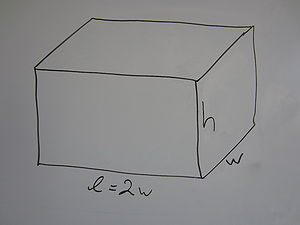Science:Math Exam Resources/Courses/MATH104/December 2013/Question 04
{{#incat:MER QGQ flag|{{#incat:MER QGH flag|{{#incat:MER QGS flag|}}}}}}
• Q1 (a) • Q1 (b) • Q1 (c) • Q1 (d) • Q1 (e) • Q1 (f) • Q1 (g) • Q1 (h) • Q1 (i) • Q1 (j) • Q1 (k) • Q1 (l) • Q1 (m) • Q1 (n) • Q2 (a) • Q2 (b) • Q2 (c) • Q2 (d) • Q2 (e) • Q2 (f) • Q2 (g) • Q3 • Q4 • Q5 • Q6 (a) • Q6 (b) • Q6 (c) •
Question 04 |
|---|
|
A rectangular storage container with an open top is to have volume of 8 cubic metres. The length of its base is twice the width. Material for the base costs $4.50 per square metre, and material for the sides costs $6 per square metre. Find the cost of the material for the cheapest such container. |
|
Make sure you understand the problem fully: What is the question asking you to do? Are there specific conditions or constraints that you should take note of? How will you know if your answer is correct from your work only? Can you rephrase the question in your own words in a way that makes sense to you? |
|
If you are stuck, check the hint below. Consider it for a while. Does it give you a new idea on how to approach the problem? If so, try it! |
Hint |
|---|
|
A simple picture here can get you started. The two constraints let you reduce this to a single variable problem. |
|
Checking a solution serves two purposes: helping you if, after having used the hint, you still are stuck on the problem; or if you have solved the problem and would like to check your work.
|
Solution |
|---|
|
We wish to minimize the cost, C, subject to the constraint that the length of the base is twice it's width and that the volume of the container must be .
since material for the base costs $4.50 per square metre, and material for the sides costs $6 per square metre.
Using the fact that the length is twice the width (i.e., l = 2w), the cost function and volume constraint are expressed as
and substitute this into the cost function C, making it a function of w only:
which is clearly greater than zero when w = 2. Thus, by the second derivative test, C has a local minimum at w = 2 (Moreover, it is the global minimum since there are no other critical points.) Substituting w = 2 into the cost function, we determine that the minimum cost is |
{{#incat:MER CT flag||
}}










